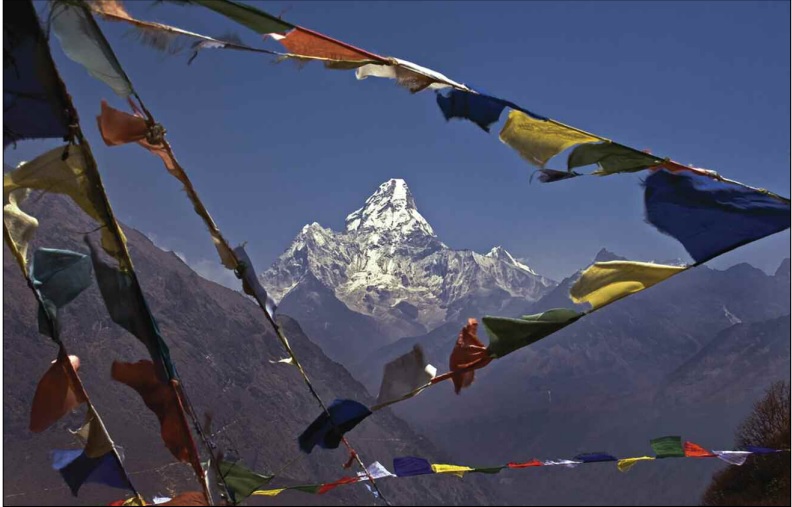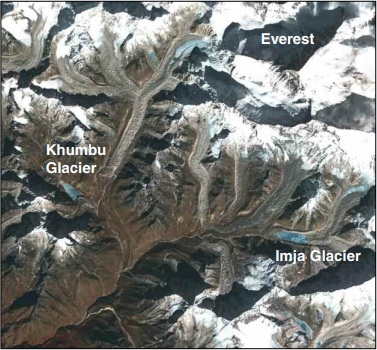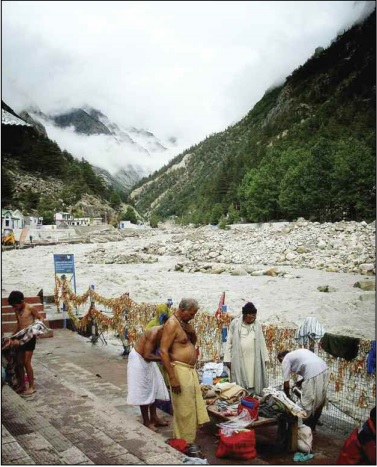From the air, the Himalaya Mountains resemble white meringue whipped into sharp peaks that froth from horizon to horizon. Look more closely, and the Himalaya are dotted by thousands of smaller peaks: temples, shrines, pagodas, and monasteries. For in Southeast Asia, water is everything, and these monuments testify how the Himalaya are revered as the birthplace of dozens of major rivers that help to sustain more than three billion people.
At the heart of this birthplace are 15,000 glaciers, frozen reservoirs whose meltwater feeds the rivers that flow through the mountains. In fact, the headwaters for India’s holy river, the Ganges, issue from the massive Gangotri Glacier system.
Scientists and the media have skirmished over reports that the Himalaya’s glaciers will melt by 2035; in reality the glaciers are in no danger of disappearing any time soon. But, like many glaciers in the region, the Gangotri overall is receding, leaving scientists to wonder what will happen to Asia’s water supply if the glaciers continue to lose ice.
Gleaning data from glaciers
Information about individual glaciers is sparse because, just as snow and ice lay claim to the Himalaya, so do several countries. For instance, the region’s longest glacier, the Siachen, winds through disputed territory administered by India but claimed by Pakistan. Boundary squabbles and political unrest compound the jagged, remote geography that makes travel and research in the Himalaya difficult.
One of the scientists investigating glaciers in the Himalaya is Jeffrey Kargel at the University of Arizona. He and his colleagues are looking at glacier shapes and outlines in the Himalaya to determine which glaciers are shrinking, growing, or remaining stable. Glaciers continually adjust their size and flow speed to seek equilibrium with climate, which is always shifting: for a glacier to remain stable, just enough annual snowfall must accumulate at the head of the glacier to balance out the seasonal melting that takes place near the foot of the glacier. Excess snow causes the glacier to grow, and excess melting will cause glacier recession. Scientists can often see these changes reflected in the glacier’s extent and shape.
Although topographic maps and aerial images of the Himalaya provide a historical perspective on glacier extent, they often do not reflect recent glacier changes. Kargel and his colleagues needed newer glacier images for comparison. They used images from the Global Land Ice Measurements from Space (GLIMS) project, managed by NASA's National Snow and Ice Data Center Distributed Active Archive Center (NSIDC DAAC). GLIMS offers a global database of both glacier outlines and satellite imagery for studying glaciers.
However, there is a catch to using satellite imagery of the Himalaya glaciers, according to Adina Racoviteanu at the University of Colorado. Racoviteanu said, “The first challenge is choosing adequate images for glacier delineation—there are different factors to consider.” It might seem simple to snap an image from space, but glaciers can be tricky to spot during certain times of the year. “Images need to be highly contrasted to detect glacier ice, and they should be acquired at the end of the ablation season, when the snow cover is minimal. Snow on the glacier surface poses challenges in mapping glaciers. Furthermore, in some parts of the Himalayas, monsoon clouds pose challenges for optical sensors because you can’t see the glaciers,” she said.
Much of the satellite imagery in the GLIMS database comes from the Advanced Spaceborne Thermal Emission and Reflection Radiometer (ASTER) sensor, which provides photograph-like images of glaciers. Racoviteanu and Kargel, both members of the GLIMS team, made special requests to NASA's Land Processes DAAC (LP DAAC), which archives ASTER data, to obtain images over specific glaciers. The researchers received numerous satellite scenes of the Himalaya region acquired between 2001 and 2010. Nearly a thousand of these images were captured during autumn, an ideal time period because it falls after the cloudy summer monsoon season but before winter snows obscure the land surface. In addition, the researchers received 115 ASTER scenes between September and November 2006, when Racoviteanu was collecting field measurements in the region to help validate the satellite-based glacier mapping.
By comparing these newer remote-sensing derived glacier outlines with older data sets derived from topographic maps or older imagery, scientists can begin to see how glaciers are changing. Kargel said, “You can take topographic maps produced the old-fashioned way, from say the 1950s or the 1960s, and compare with ASTER topography, and then you may have a baseline of 50 years.”
Kargel and Racoviteanu are seeing that glaciers are not responding to climate uniformly: Glaciers in certain areas of the Himalaya are behaving differently from glaciers in other parts of the massive range. Some glaciers in the western Himalaya and neighboring Karakoram Range, such as the Baltoro Glacier of Pakistan, are growing. And most of the melting glaciers, such as the Gangotri and Imja, are located in the central and eastern Himalaya. What accounts for the difference between the eastern and western ends of the range?
Atmosphere and ice
The researchers, together with other colleagues, found a clue in the intersection of atmospheric forces swirling above the region. Cold, dry winds blowing south from the Tibetan Plateau clash with moisture-laden monsoon winds swinging north from the Indian Ocean. In the past, this pattern generated enough snow to sustain glaciers across the Himalaya. But combusted carbon and dense air pollution increasingly cloud the skies over Asia, changing precipitation in some areas and increasing melt in others.
Much of this pollution is natural in origin, and includes dust, desert sand, and salt particles. But in South Asia most of the air pollution, particularly black carbon, or soot, is generated by human activity. Kargel said, “In South Asia, brick ovens are a major source of soot. Automobile tires wear down and that puts little rubber particles in the atmosphere. Coal-fired plants produce a lot of soot. And combusting gasoline in automobiles and other engines creates soot.”
Soot is a new addition to glaciers already covered with debris. “There’s this unsteady, quasi-balance of forces between the building up and the wearing down that produces a huge amount of rock debris. That’s mostly what we see from satellites,” Kargel said. “But the soot is a very different kind of thing. In terms of particle size, we’re talking about microns. Perhaps a thousandth of a millimeter, or ten thousandths of an inch to maybe a thousandth of an inch across.” These tiny particles of pollution may be affecting Himalayan glaciers on two fronts: by precipitating directly onto the glacier surfaces and by causing overall atmospheric warming in the region.
If soot falls onto the cold upper reaches where glaciers accumulate ice, the particles may be buried and incorporated into the glacier ice, and have little effect on melting. But if soot falls onto the lower reaches of a glacier or the glacier tongue, particles often remain on the surface. “Instead of having a highly reflective surface, the glacier then has a somewhat less reflective surface,” Kargel said. “It absorbs more solar radiation, and there’s more melting that can go on.”
Soot that remains in the atmosphere also absorbs solar radiation, causing an “elevated heat pump.” Kargel and his colleagues, following research conducted by NASA’s William Lau and other physicists and climatologists, theorize that this heat pump is blowing large amounts of monsoon moisture farther north than would have been the case otherwise. “This may be a possible cause of additional atmosphere heating beyond that which the greenhouse effect causes, thereby possibly explaining the accelerated melting of glaciers in the eastern Himalaya,” he said.
The effects of the elevated heat pump may be changing both regional air temperature and monsoon precipitation patterns over the range. Increased atmospheric heating is causing many glaciers to melt along the southeastern end of the range, where the Gangotri Glacier is located. But the increased moisture caused by the heat pump is being blown to the northwest, where it falls as snow over the high elevations, possibly aiding the growth of glaciers in that region, such as the Baltoro, according to Kargel.
Whence the water
Just as monsoon rains dominate agricultural life across Southeast Asia, monsoon moisture fuels much of the snow that feeds glaciers in the higher elevations. If the monsoon cycle is changing, or if the elevated heat pump shifts snowfall and precipitation, the results could affect how much fresh water is available for agriculture and drinking. Although much of Southeast Asia and China are wet, humid areas, people in the region do rely at least in part on seasonal glacier melt for water during dry times of the year. Racoviteanu said, “It all comes back to water resources. There’s a missing link. We still don’t have a good idea of how much water is actually coming from glaciers, as opposed to coming from ice or snow.”
Researchers are still trying to assemble a more complete picture of the climate factors affecting the glaciers. Although Kargel and Racoviteanu have begun to investigate some of the large glacier systems, the dearth of information about the thousands of other glaciers makes it difficult to understand the consequences of glacier change—or what role the Himalaya’s glaciers play in Asia’s water supply. Kargel said, “We don’t yet fully understand all of the complexities. Atmospheric soot is a player, but it’s not the only major story going on. The biggest story going on is global warming and changing monsoons.”
References
Bishop, M.P., et al. 2004. Global Land Ice Measurements from Space (GLIMS): Remote sensing and GIS investigations of the Earth's cryosphere. Geocarto International 19(2): 57-84, doi:10.1080/10106040408542307.
Lau, W.K.M., M.-K. Kim, K-M. Kim, and W.-S. Lee. 2010. Enhanced surface warming and accelerated snow melt in the Himalayas and Tibetan Plateau induced by absorbing aerosols. Environmental Research Letters 5(2), doi:10.1088/1748-9326/5/2/025204.
Racoviteanu, A.E., M.W. Williams, and R.G. Barry. 2008. Optical remote sensing of glacier characteristics: a review with focus on the Himalaya. Sensors 8: 3,355-3,383, doi:10.3390/s8053355.
United Nations Environmental Programme. 2007. Chapter 6B: Glaciers and ice caps. In Global Outlook for Ice and Snow. Norway: United Nations Environment Programme.
For more information
NASA National Snow and Ice Data Center Distributed Active Archive Center (NSIDC DAAC)
NASA Land Processes Distributed Active Archive Center (LP DAAC)
Advanced Spaceborne Thermal Emission and Reflection Radiometer (ASTER)
Global Land Ice Measurements from Space (GLIMS)
| About the remote sensing data | ||
|---|---|---|
| Satellite | Terra | |
| Sensor | Advanced Spaceborne Thermal Emission and Reflection Radiometer (ASTER) | |
| Data set | Global Land Ice Measurements from Space (GLIMS) Glacier Database | |
| Resolution | 15 meter | |
| Parameter | Glacier extent | |
| DAAC | NASA National Snow and Ice Data Center Distributed Active Archive Center (NSIDC DAAC) | |
ASTER satellite images are available from LP DAAC.


